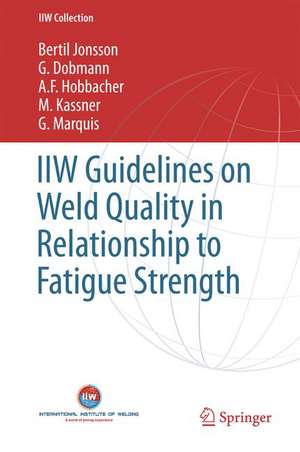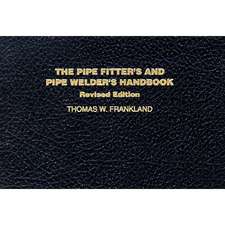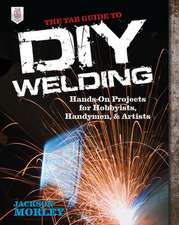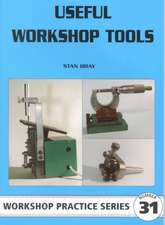IIW Guidelines on Weld Quality in Relationship to Fatigue Strength: IIW Collection
Autor Bertil Jonsson, G. Dobmann, A. F. Hobbacher, M. Kassner, G. Marquisen Limba Engleză Hardback – 21 apr 2016
This book presents guidelines on quantitative and qualitative measures of the geometric features and imperfections of welds to ensure that it meets the fatigue strength requirements laid out in the recommendations of the IIW (International Institute of Welding). Welds that satisfy these quality criteria can be assessed in accordance with existing IIW recommendations based on nominal stress, structural stress, notch stress or linear fracture mechanics. Further, the book defines more restrictive acceptance criteria based on weld geometry features and imperfections with increased fatigue strength. Fatigue strength for these welds is defined as S-N curves expressed in terms of nominal applied stress or hot spot stress. Where appropriate, reference is made to existing quality systems for welds.In addition to the acceptance criteria and fatigue assessment curves, the book also provides guidance on their inspection and quality control.
The successful implementation of these methods depends on adequate training for operators and inspectors alike. As such, the publication of the present IIW Recommendations is intended to encourage the production of appropriate training aids and guidelines for educating, training and certifying operators and inspectors.
| Toate formatele și edițiile | Preț | Express |
|---|---|---|
| Paperback (1) | 575.93 lei 6-8 săpt. | |
| Springer International Publishing – 22 apr 2018 | 575.93 lei 6-8 săpt. | |
| Hardback (1) | 724.80 lei 6-8 săpt. | |
| Springer International Publishing – 21 apr 2016 | 724.80 lei 6-8 săpt. |
Preț: 724.80 lei
Preț vechi: 883.91 lei
-18% Nou
Puncte Express: 1087
Preț estimativ în valută:
138.71€ • 144.28$ • 114.51£
138.71€ • 144.28$ • 114.51£
Carte tipărită la comandă
Livrare economică 15-29 aprilie
Preluare comenzi: 021 569.72.76
Specificații
ISBN-13: 9783319191973
ISBN-10: 3319191977
Pagini: 130
Ilustrații: XIII, 115 p. 58 illus., 32 illus. in color.
Dimensiuni: 155 x 235 x 10 mm
Greutate: 0.36 kg
Ediția:1st ed. 2016
Editura: Springer International Publishing
Colecția Springer
Seria IIW Collection
Locul publicării:Cham, Switzerland
ISBN-10: 3319191977
Pagini: 130
Ilustrații: XIII, 115 p. 58 illus., 32 illus. in color.
Dimensiuni: 155 x 235 x 10 mm
Greutate: 0.36 kg
Ediția:1st ed. 2016
Editura: Springer International Publishing
Colecția Springer
Seria IIW Collection
Locul publicării:Cham, Switzerland
Public țintă
Professional/practitionerCuprins
Introduction.- Design for Purpose.- iiw Fatigue Assessment Procedures.- Classification of Weld Imperfections and Features.- Weld Quality Levels for Fatigue Loaded Structures.- Root Side Requirements.- Inspection, Quality Control and Documentation.- Fitness for Service.
Notă biografică
The authors are well-known professional Researchers in Welding technology and material sciences.
Textul de pe ultima copertă
This book presents guidelines on quantitative and qualitative measures of the geometric features and imperfections of welds to ensure that it meets the fatigue strength requirements laid out in the recommendations of the IIW (International Institute of Welding). Welds that satisfy these quality criteria can be assessed in accordance with existing IIW recommendations based on nominal stress, structural stress, notch stress or linear fracture mechanics. Further, the book defines more restrictive acceptance criteria based on weld geometry features and imperfections with increased fatigue strength. Fatigue strength for these welds is defined as S-N curves expressed in terms of nominal applied stress or hot spot stress. Where appropriate, reference is made to existing quality systems for welds.In addition to the acceptance criteria and fatigue assessment curves, the book also provides guidance on their inspection and quality control.
The successful implementation of these methods depends on adequate training for operators and inspectors alike. As such, the publication of the present IIW Recommendations is intended to encourage the production of appropriate training aids and guidelines for educating, training and certifying operators and inspectors.
Caracteristici
Provides quantitative and qualitative measures of the geometric features and imperfections of welds Defines more restrictive acceptance criteria based on weld geometry features and imperfections with increased fatigue strength Offers guidance on inspections and quality control, acceptance criteria and fatigue assessment curves Includes supplementary material: sn.pub/extras















